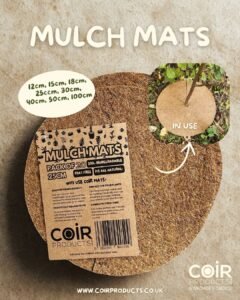
Transform Your Garden with Biodegradable Mulch Mats
In a world where every choice we make ripples through our planet and our personal sanctuary, your garden deserves more than the ordinary. It deserves

What do you love most about January when it comes to gardening? Is it the sense of unwinding that winter brings or the excitement of looking forward to a new growing season very soon?
January is a great time to start planning for your next growing season, whether it’s deciding what you want to sow and grow, getting to know your soil, or thinking about the type of growing media you need.
In today’s blog post, we’ve rounded up five tips to get you planning your next growing season.
Get to know your garden: Whether you are a seasoned grower or new to gardening, it’s always worthwhile spending some time getting to know your garden. What is your soil like, how much space do you have, where does the sun fall, which parts have more shade…that’s just a few of the questions to think about. You might need to prepare your soil for planting or give your space a little tidy up, removing any unwanted debris. Getting to know your garden will also help you choose the right location when it comes to growing.
Grow what you love to eat: If you are unsure of what to grow, a great place to start is by thinking about what you love to eat. You could also think back to your last growing season – what were some of your favourite crops to grow, what worked, what didn’t, what do you want to try this year? Once you’ve decided on that, write down how much of each you need. This would also help you save money, time, and energy.
Do your research: Knowing the requirements of each plant is important to better understanding when and how to plant them and the conditions they need. With some plants, you might need to wait for the last frost date, while you might be able to sow some seeds under cover. Some plants need full sun, while others require partial shade. Some plants need regular watering. Do a bit of research beforehand, and write down a schedule, so that you make the most of the growing season.
Map out your garden: Draw a map of your garden and mark out the space or plots in your garden, so that you can plan out what to grow and where. Plan your crop rotation. Crop rotation involves growing specific sets of vegetables in different parts of the plot every year. This helps reduce pest and disease problems. You can organise crops depending on their cultivation needs. You can also intercrop, where you grow another crop between others. You might also want to think about companion planting and planting for wildlife.
Use sustainable growing media: Coir products are natural and eco-friendly, and there is minimal harm on the environment in using or producing them. Coir products are made with the natural and organic material extracted from the husk of the coconut, and as such they are completely free of the more harmful peat-moss. Our growing media includes our coir potting mix that comes in a variety of sizes of blocks, bricks, and discs, as well as our fully biodegradable CoirCoins for sowing With the UK government banning the use of peat in horticulture, as the extraction of peat is causing harm to biodiversity and the environment, coir products are the ideal alternative. In fact, the natural properties of coir means it decomposes into the soil, enriching the soil over time. Not only that, at CoirProducts.co.uk, we also don’t use any unnecessary plastics in our packaging. So if you are looking to move away from those plastic pots and containers, we’ve got an exciting range of eco-friendly coir pots for you to choose from.
With plenty to look forward to, get planning!

In a world where every choice we make ripples through our planet and our personal sanctuary, your garden deserves more than the ordinary. It deserves

We continue our special series highlighting grower’s experience of using coir with Kay @brook_cottage_. With a love for growing a mix of flowers, fruits, and